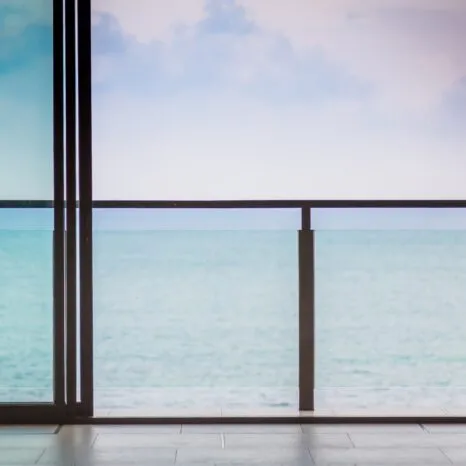
Professional and flawless installation of external doors is very important. First and foremost, it prevents thermal bridges that promote heat loss, provides us with a comfortable and aesthetically pleasing finish, but also protects us from burglars. A well-installed exterior door should also open and close smoothly and silently. If this is not the case, it is the first sign that something has gone wrong during installation. So how do you go about properly installing your entrance door? Let’s find out.
When should I start installing external doors?
It is worth bearing in mind that window and door joinery should serve us for many years – if properly installed, of course. This is why doors should only be fitted after the finishing work has been carried out. Why? Well, a lot of mechanical work can damage the door leaf or the door frame. Of course, we can buy such doors in advance and store them packed in a safe place, but we should only install them after the finishing works have been completed. Until then, we can use temporary solutions that we will throw away once the construction is complete.
Steps in the installation of an external door
If we are already ready to proceed with the installation of the external doors, it is important to bear in mind that this also takes place in stages. We can divide the essential work into four stages and these include:
Stage I – Preparing the wall opening
At the initial stage of the frame installation process, it is important to carefully prepare the hole in the wall that will be its destination. It is worth paying attention to the precise dimensions to ensure that the frame is seated correctly. Therefore:
- The height of the space should be 1-1.5 cm higher than the door frame.
- The width of the opening should be 2-3 cm wider than the door frame.
Alternatively, even spacing can also be maintained on each side of the opening. Specific dimensions may vary depending on the model of frame or type of hinges used, so it is advisable to check the recommended dimensions on the manufacturer’s website before purchasing. Obtaining the joinery in advance makes the whole process easier, allowing you to prepare a properly sized opening in advance and minimising the risk of problems associated with later adjustments. Care should also be taken to ensure that the edges of the opening are smooth and even to facilitate the installation of the frame.
In the case of unusual solutions which require modifications to the wall, it is always advisable to consult a professional. After all, acting without proper understanding can lead to damage to load-bearing elements such as the lintel, which plays an important role in stabilising the building structure in the door area.
Stage II – Assembly of the frame
If we already have the opening for the exterior door properly made, we can finally get down to assembling the door frame. Usually the door frame is brought to us in parts, but assembling it ourselves is a fairly straightforward task. All we need is a piece of flat surface on which to join the vertical frames with the horizontal frame and the so-called blind sill.
It should also be remembered that, in order to avoid thermal bridges, the frame should be installed in a location that depends on the wall structure. In theory, it is assumed that the symmetry axis of the frame cross-section should be at the point where the neutral temperature, i.e. 0 °C, prevails in the wall at minus 15 °C. In practice, this means that:
- In the case of single-layer walls, the frame should be set halfway through the thickness of the wall.
- In the case of two-layer walls, the frame should be set close to the outer edge of the wall.
- In the case of three-layer walls, on the other hand, the frame should be placed at the height of the insulation layer.
We adjust the position of the frame with wedges and, if necessary, it’s a good idea to use a protractor and a spirit level, so that we can maintain a level and right angles. To make sure the measurement has been taken correctly, we can put the door on the frame and swing it slightly. If they remain still, this is a good sign, telling us that we can proceed with further work.
We are, of course, talking about fixing the frame with screws and metal dowels, which are fastened to pre-drilled holes in the masonry. To do this, we use 6 to 8 elements spread evenly over the entire surface – this, however, depends on the type of door.
Stage III – Insulation of external doors
The final stage of the work is the actual insulation of the space between the door frame and the wall. To do this, we use low-pressure foam injection. This procedure is carried out using a special gun. Thanks to the unique properties of the foam, which doubles in volume, it is not necessary to over-insulate and we can easily reduce thermal bridges in hard-to-reach areas. However, it is advisable to protect the door frame beforehand with painter’s tape, available at any building supplies shop, to protect it from accidental foam application.
In situations where too much foam has been used, door mounting struts can be used to prevent deformation of the door frame. In the absence of ready-made struts, carefully measured boards will also work perfectly.
The foam usually cures in about 24 hours. After this time, the excess foam can be cut off with an upholstery knife. An important aspect that is often overlooked is the correct installation of the threshold. Insufficient stability of this element can lead to cold air and dampness penetrating into the interior, which can quickly be felt in the form of higher heating bills and problems with dampness or even mould near the door. This is why it is worth paying special attention to a solid installation of the threshold in order to avoid unpleasant consequences.
Stage IV – installation of doors
Finally, we are left with the theoretically simplest stage, that of fitting the door. We start this process by completing the door joinery with the handle and closing hardware. In addition, if the hinges are not an integral part of the frame, we should screw them on. These tasks should take us several minutes. Then, we hang the door on the hinges and check that everything is functioning properly, i.e. that the door opens slightly, presents no resistance and is soundless when moving.
In addition, it is worth bearing in mind that the sash should not bump against the wall or the kerf when opening. If this is the case, it is advisable to fit rubber buffers to limit their range of movement. Always pay attention to any instructions enclosed with the door and perform each operation precisely. This will ensure good heat insulation, an aesthetically pleasing appearance and smooth operation of the door.
Remember the door guarantee
An extremely important aspect when buying a new door is to make sure that the product comes with a guarantee. Today’s manufacturers offer a variety of warranty periods, usually ranging from two to as long as ten years. It is therefore worth taking the time to familiarise yourself thoroughly with the terms of the guarantee, as in many cases there is a requirement for installation to be carried out by a team of specialists authorised by the manufacturer – otherwise you could automatically lose the guarantee. Another key condition for the warranty to apply is that the door is installed correctly. It is therefore important to ensure that you read and understand the warranty conditions carefully in order to avoid unpleasant situations in the future. Protecting yourself in this way will allow you to enjoy peace of mind and the certainty that your purchased door is covered by the manufacturer’s comprehensive protection.


















